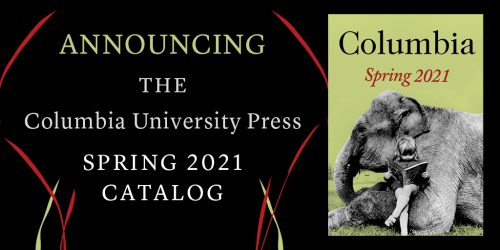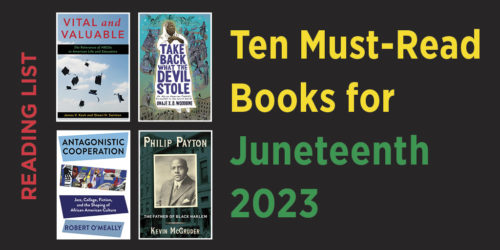Robert G. O’Meally in Conversation with Justin Liang About Antagonistic Cooperation

From the collages of Romare Bearden and the paintings of Jean-Michel Basquiat, to the fiction of Ralph Ellison and Toni Morrison, to the music of Louis Armstrong and Duke Ellington, in Antagonistic Cooperation: Jazz, Collage, Fiction, and the Shaping of African American Culture Robert G. O’Meally explores how the worlds of African American jazz, art, and literature have informed one another. In celebration of Juneteenth, Justin Liang and Professor O’Meally discuss the theory of antagonistic cooperation.
Justin Liang: There are a number of striking conceptual turns in your book, most notably the theory of “antagonistic cooperation” that gives the book its title. You also intriguingly raise the notions of the “ecstasy of influence,” the “open corner,” and “unruly Black cosmopolitanism.” How would you say these ideas relate to one another?
Robert G. O’Meally: Two of these terms refer to Black American art at its best: first, to the quality I love the most in our art, which I term “unruly Black cosmopolitanism,” an audacious will to create truth-telling art no matter who does or does not like it—think of Audre Lorde or Cecil Taylor or James Baldwin, telling the Black story all up in your face; Romare Bearden with his knife, slashing at his boards and papers; Basquiat attacking a canvas, dripping paint over the edges. The second points to the artist’s “Say Amen Somebody” invitation for the audience to participate in the creation of a given work, a strategy that, following the artist Romare Bearden’s lead, I term the “open corner.” Think here of the jazz composer’s chart marked “Ad Lib,” the part left open for the soloist’s free invention; or of Toni Morrison’s novel Jazz, where the narrator says to the reader, What’s next? What do you think? You’re holding the book!
The other terms you mention, “antagonistic cooperation” and “ecstasy of influence,” attempt to make clear that Black artists (all artists) thrive on the examples set by other artists—[John] Coltrane adored Charlie Parker’s sound and facility on the horn; they filled him with “ecstasy of influence.” And yet like Bird, Trane was a master of the head-cutting gladiatorial sessions in which he played with and then against all other players around him—with all participants hotly in search of better and better ways to get their stories told. In other words, Trane played against Bird, too, as he sought the piece he felt was missing in Parker’s playing while at the same time he sought his own sound. Think here of the fierceness of a contest between, say, Serena and Venus Williams, playing harder than hard, pushing each other to play better than ever. There’s a hard exhalation of air with every pop of ball against these tough competitors’ rackets! This formula works best, I’ve noticed, when the hope-to-die competitors love one another like sisters and brothers, and they also love the forms through which they are expressing themselves. In this sense it could be said that all of these terms are about art propelled by love.
This is not an all-Black circle of influences, either. William Shakespeare and Mark Twain were masters of the open corner, too. As a composer Billy Strayhorn pushed back against the French Impressionists, whom he loved; Bearden pushed back against Matisse, whom he loved. Maybe Strays pushed back against Matisse, too. No doubt white composers are doing their best, today, to out-Duke Mr. Ellington! Bearden tried to out-Trane Coltrane. In other words, I find it important, certainly in the context of Black American art, that lines of influence crisscrossed. Everybody in Black art paid close attention to the wonderful example of the music.
Liang: The breadth of scholarship in this book is remarkable: you bring together and put into conversation luminaries from the worlds of jazz, art, literature, and film. What inspired you to write such a wide-ranging and interdisciplinary work? Was there a particular thread from which you began your process of inquiry?
O’Meally: I came of age during the Black Arts Movement of the 1960s. [Amiri] Baraka’s plays, which I began seeing in the mid-1960s, always involved music. Nina [Simone]’s music, which I first heard in 1966, was always strongly peppered with politics and drama. She and her close friend Langston Hughes wrote at least one song together. (She and Baraka were also tight friends.) The AFRICOBRA artists at Howard University—where I taught for three years—were consciously trying to paint the music of that era. The studios of Alfred Smith and James Phillips were booming with music from all over Africa, from the Caribbean, and especially from the discs of Coltrane and Cecil Taylor. And so it never made sense to me to treat art forms apart from one another or apart from the heat and light of the ongoing political struggle. If there was an Aha! moment for me, I guess ironically it came from reading Ellison’s Invisible Man—by someone worlds away from the Black Arts Movement, but also someone enlisted for life in affirming Black life and culture. I was trying my best to play saxophone in those high school/early college years (it was an earnest effort but a sad one, though I’ll always be grateful for playing in high school orchestras and in the marching band), and Ellison’s prose was so precise, so elegant, so musical! And when he described a sound he wanted you to hear—a preacher’s sing-song eloquence, or a street musician’s rowdy horn lifted above a crowd of marchers—he’d been there!
Then too, since the mid-1970s I was close to the writer Albert Murray, who when I met him was working on his jazz aesthetics book called Stomping the Blues. He would call me up and read a passage, then ask, “As I read, can you hear the Lion’s ragtime left hand that just won’t let up?!” At that time Murray also was working closely with Bearden on a word-and-image project called the Profile series. Over the last thirty-five years at Columbia and Barnard, Aha! moments have come to me all the time, too, through the ongoing interactions, formally and informally, with my Columbia colleagues—Edward Said, Mary Gordon, Gayatri Spivak, Brent Edwards, Farah Griffin, Ann Douglas, George Lewis, Saidiya Hartman, and others. Just a casual remark in the hallway from one of these folks can make my head spin for days—for years! In my head I still talk with Edward, now gone for twenty years, and see him shake his head and pose a question I’d failed to consider.
Liang: In chapter 1 you write that “jazz … both is and demands aesthetic action that is inherently political.” Your scholarship is a reminder of the revolutionary potential of jazz as a genre. To many a layperson, however, jazz (especially its offshoots, such as “smooth jazz”) has become more commercialized and domesticated. Would you consider music in this form to still be jazz, or is it something else? Would its listeners benefit from reading your book?
O’Meally: Well, I’d say there’s good jazz, and there’s always what Ellington called the other kind—just as you have sad imitations of Beethoven and Chopin, trivializations. Such poor stuff will always be with us, I guess. My writing here and everywhere celebrates the deep and churning stream of the music of Bessie Smith, James P. Johnson, Louis Armstrong, and their artistic children. In all these cases the will to affirm the Black group can be felt, along with the assertion of an individuality in spite of all the efforts to shut us down! And with that is the assertion of the ensemble, the call-and-recall exchange that reminds us that the individual alone can only say so much—the rest is a group thing, a conversation of the one with the many. This music is revolutionary because it is restless and will not settle; it looks for new horizons: Think again, it insists, revise the text, turn the soil over—time for new plantings! Bessie’s and Billie [Holiday]’s sound called for revolution. Louis’s too. The commercial or domesticated players you’re asking about are playing for points, for tossed coins. The great ones like Johnny Hodges and Melba Moore wore their instruments, Ellison said, as priests wore crosses! Sarah Vaughan and Wynton Kelly were performing as if their lives depended on it; forget sales—at least in the moment of creating. The commercial ones are okay for the elevator when you’re on vacation. But the flesh-and-blood music of the Black tradition is much bigger than this. Vijay Iyer! Courtney Bryan!
Liang: Your book argues for a reconsideration of Louis Armstrong and Ralph Ellison as “masters of antagonistic cooperation” who have nonetheless been “pushed … out of the groove of history.” What do you think a reintroduction of these two figures offers to contemporary readers?
O’Meally: Well, these are two of the greatest figures of the twentieth century. And in his time Armstrong may have been the single most well-known celebrity in the world, the Muhammad Ali of the 1950s and ’60s. Ellison’s Invisible Man was translated into every major language (twice into French!), and by the 1960s was required reading all over the United States and taught in colleges and universities everywhere. Nonetheless, for many people under forty, these great figures now are totally unknown. Armstrong changed the direction of world music, both as a virtuoso instrumentalist and as a fantastically inventive singer. Stanley Crouch said, “It’s as if Beethoven stood up from the piano and began to sing!” Most musicians know this—not only jazz musicians but musicians across the categories, across the planet, they know this. Younger musicians who don’t know his name nonetheless are influenced by Armstrong via some other artist who studied Armstrong directly. Reintroducing him to young artists challenges them to go to directly to the source. Reintroducing him also invites Armstrong fans who know only the early Armstrong (the amazing Hot Five and Hot Seven records), or only the Armstrong of the middle years, the 1940s, or only the late Pops to listen to the whole shelf of recordings. All of it is fantastically compelling. All of it. His late-career duets with Ella [Fitzgerald] and with Billie prove that he continued to grow, to surprise. Get his record with Ellington! Or his tribute to W.C. Handy! My book argues that beyond the music lessons, Armstrong had much to teach about living productively, living with a will to uplift the world, to change it.
Ellison’s story is similar. Once standard reading, his novel has disappeared from high school honors English lists. I see it coming back to college lists, which signals a change for high school curricula too. As with Pops, Ellison suffered from a generational shift as teachers and other readers turned elsewhere. He fell out of style with those who’d grown up on Malcolm X and the Black Arts Movement writers. But Ellison’s work stands. If there’s one novel of the mid-twentieth century greater than Invisible Man, what is it? (One reviewer called it the Moby-Dick of our nation’s freedom movement.) And Ellison’s Collected Essays is on fire! It’s as significant a reading of American culture, and particularly of the Blackness of American culture, as was ever composed. Some of those essays, like “Little Man” and “What America Would Be Like Without Blacks,” are surfacing here and there. His fantastic short fiction work of 1965 called “Juneteenth”—obviously about that holiday long before it was a national one—is being read again. It’s a masterpiece. When I introduce Ellison writings in my Columbia classes, the students respond to the fresh point of view, the eloquence, the definitions of race and nation that endure. And to hear Armstrong for the first time offers what Said—who dug Armstrong—calls an experience that is transformative; “shattering” is the word he used.
Liang: Your book is full of unexpected connections and surprising influences: you cite, for instance, the Tang dynasty artist Wang Wei as an inspiration for Romare Bearden. In fact, the scope of your book is not only interdisciplinary but also international: in chapter 5, for instance, you locate an “unruly Black cosmopolitanism” in postwar Paris. In chapter 2, you cite the notion of collage as a “passage from unity to multiplicity … the moment when all the components of humanity—not just the African ones—consent to the idea that it is possible to be one and multiple at the same time.” How might you relate this kind of cosmopolitanism to the anxieties around appropriation that beset our contemporary culture?
O’Meally: Today we are right to beware decorating ourselves with the signs and symbols from cultures not our own. To beware strip-mining other people’s cultural treasures—as if the Christian cross or the Star of David or symbols of Islam were no more than baubles to wear or sew into our jeans. Most of us know better than that now. We know to be more careful with one another, more respectful. But can we take the next step and ask ourselves where the American language comes from? Where then our literature comes from? Where the dances we do at social gatherings come from? Where our styles of dress and walking came from? What (Ellison wants to know) would American music be without Black people’s contributions? (A chilling thought.) When we do that we realize that we are a collage of cultural influences, Native American, African, European, Asian. One thing I love about Skip Gates’s show Roots is the point that we are all much more deliciously (and sometimes embarrassingly) stirred up, culturally speaking, than typically meets the eye. My point (following Ellison) is that if we could all be more conscious of these mixes, and then more conscientious about how we treat our cultural brothers and sisters, we’d be moving toward being a more cooperative and loving community. The Black folk are part white and Asian and Native American as well as Caribbean and African; the white folk are part Black—sometimes they are so Black!; ditto our Latinx and Asian and Native peoples. Without trivializing our signs of shared cultures—by knowing not to wear our neighbor’s sacred articles to a “festive” party, for example—let us remember that in the end we are all cut from the same piece of richly textured cultural cloth.
Liang: Chapter 2 intriguingly places Romare Bearden’s art in conversation with Toni Morrison’s Jazz. How might their various approaches to collage help us imagine new models for self and community? What implications does this have for the way we conceive of American democracy?
O’Meally: When Morrison spoke at a Romare Bearden conference on Columbia’s campus in 2006, she told the assembly, mainly of students, that Bearden had given her his own collage portrait of her Song of Solomon character Pilate, and that his artwork showed her things she had not known about her own character! Earlier she had written that her fictional characters (as well as her novel’s scenes and storylines) are constructed from “pieces” that gradually she combines into “parts.” These experiences with Morrison became pieces and then parts, for me, of a theory of collage art, and indeed of the collaging of many activities, including the assembly of the self and of the community. I tell my students to start their new essay projects by assembling passages from our class readings and from our other experiences as a group, and then to see if any of the “pieces” fit together, form a pattern that could become the beginning of an argument, a “part.” Follow the energy, I tell them; let the pieces and parts—the things that fascinate and trouble you, along with things you love—direct your writing effort.
Meditating on all this, and preparing to teach Montaigne in my literature survey class, I came across a passage by the French Renaissance essayist in which he declares the human being to be a collage. “Nous sommes tous de lopins,” he says—meaning we are all a patchwork, all cut from the same material. In contemporary terms, we humans are members of a Black-white-red-yellow-brown human race—all of us, as archeology has proven, ultimately from the African continent. These two ideas, that each of us is a collage of cultural ingredients and that continuing to assemble them is a creative act, excite me. As we get dressed every morning, we are assembling ourselves; as we eat breakfast, there it is again. The next step, again, is to strive to be more conscious and conscientious about all this—with an eye to building communities that glory in our differences without forgetting our robust similarities.
This brings me back to my key terms, “antagonistic cooperation” and “ecstasy of influence”: pushing and pulling with and against one another without forgetting, as Ellison has said, that such dynamism is required of democracy, and that democracy is our nation’s word for love.






